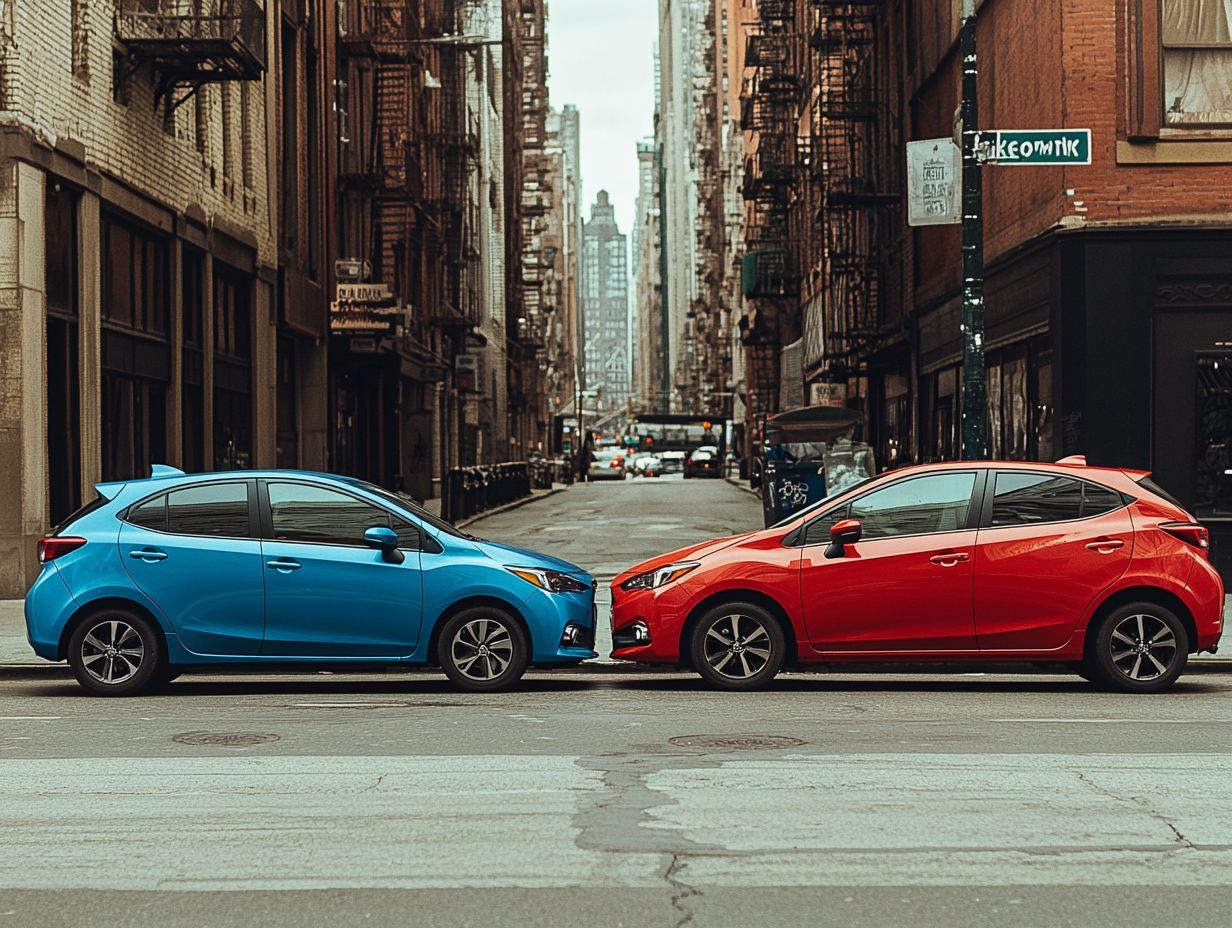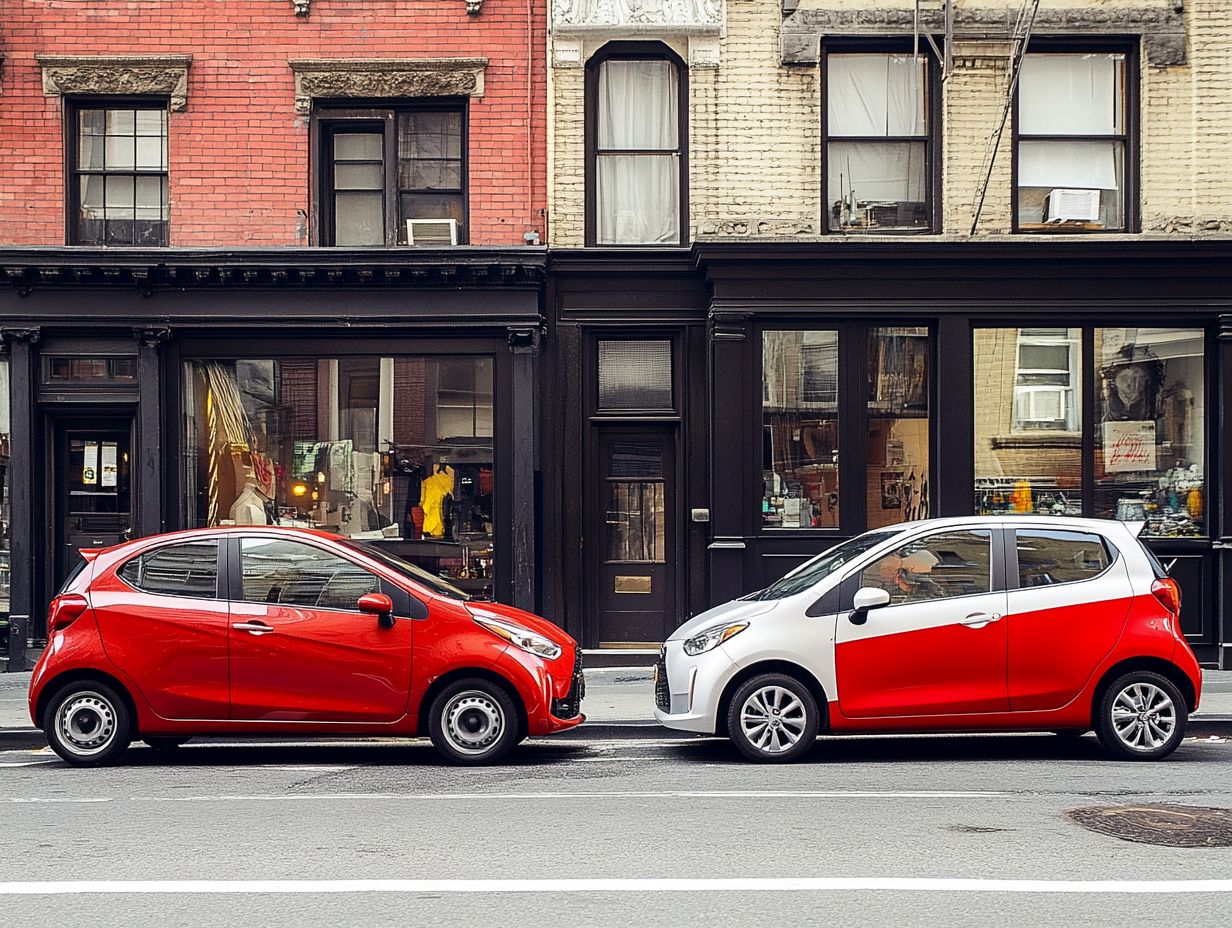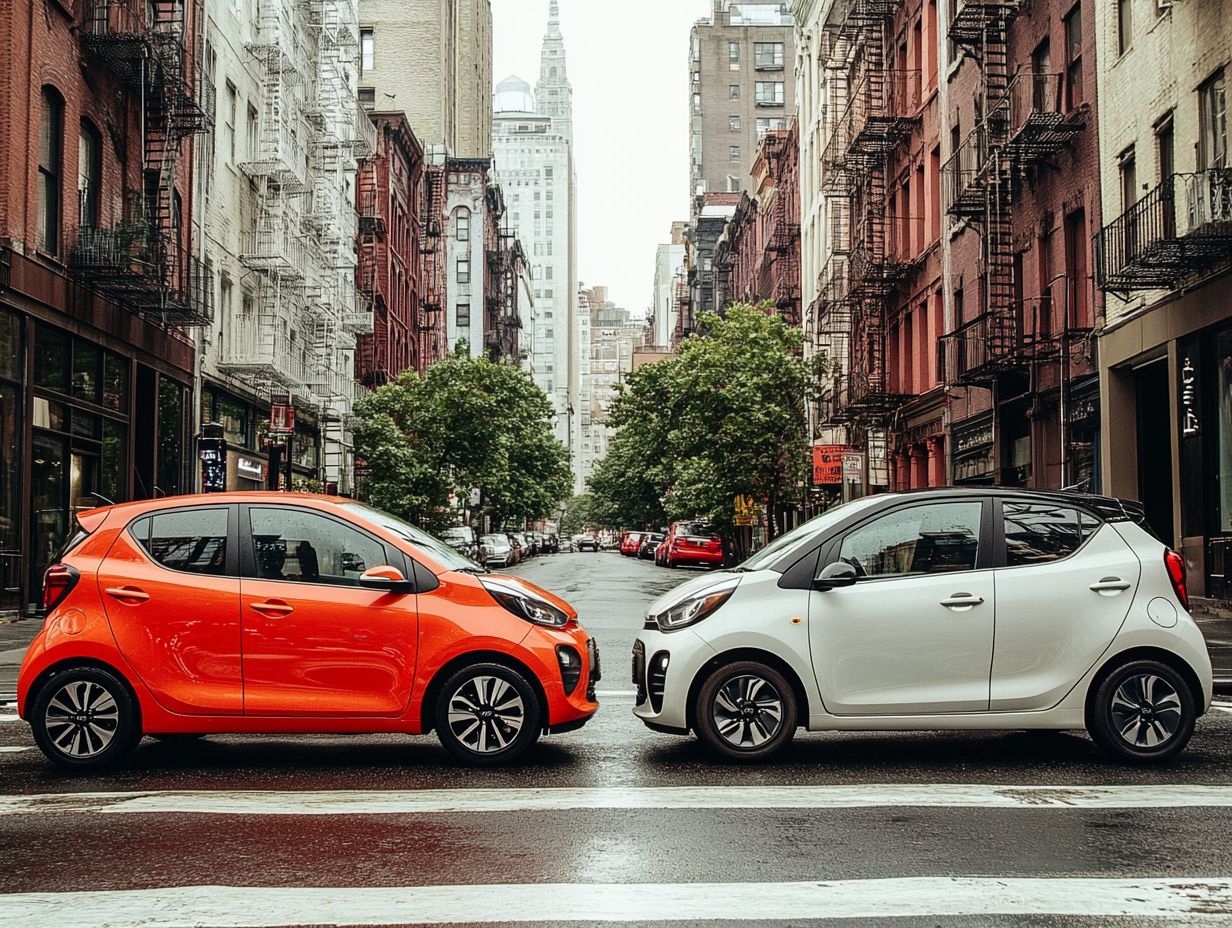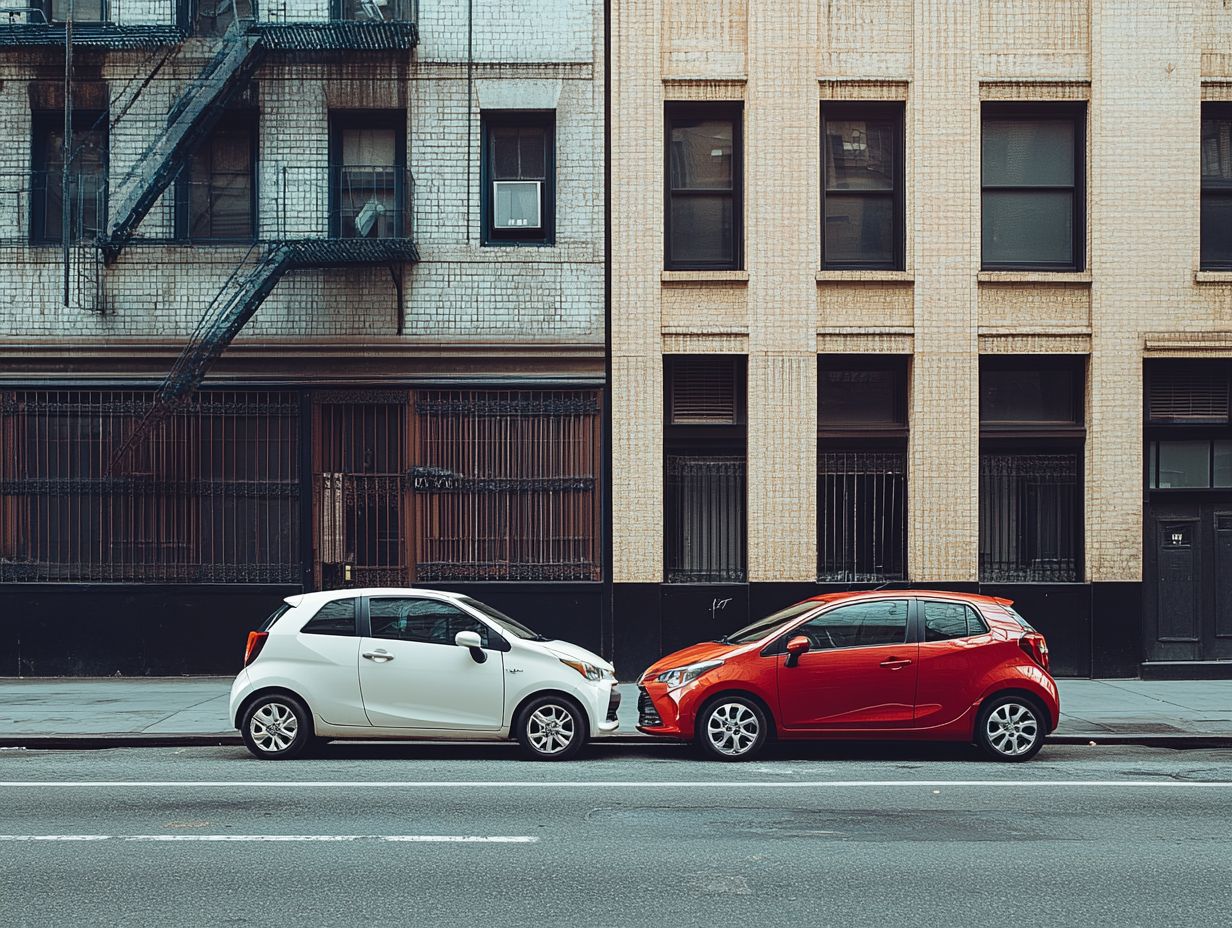Subcompact vs. Compact Cars: Price Showdown
When you’re in the market for a new car, the choice between subcompact and compact models often takes center stage.
Understanding the key differences, pricing factors, and advantages and drawbacks of each category can significantly influence your decision. This article breaks down everything you need to know, from defining the two classes to comparing their long-term values.
Ready to find your perfect car? This guide will assist you in discovering the ideal match for your lifestyle and budget.
Contents
- Key Takeaways:
- Overview of Subcompact and Compact Cars
- Price Comparison
- Subcompact Cars: Pros and Cons
- Compact Cars: Pros and Cons
- Which is the Better Value?
- Frequently Asked Questions
- What is the difference between subcompact and compact cars?
- Which type of car is typically more affordable?
- Do subcompact cars have better fuel efficiency than compact cars?
- Are there any features that are typically only found in compact cars?
- Do subcompact cars have less storage space compared to compact cars?
- Which type of car is better for city driving?
Key Takeaways:
- Subcompact cars cost less initially, but compact cars may provide better long-term value due to lower maintenance and fuel costs.
- Compact cars typically come with more features and space for a slightly higher price, while subcompact cars are more budget-friendly but may lack some amenities.
- When deciding between subcompact and compact cars, consider your needs and long-term costs to determine which option offers the best value for you.
Overview of Subcompact and Compact Cars
The automotive market presents an impressive array of vehicles, with subcompact and compact cars standing out as two of the most favored categories. Each type has its own distinct advantages, catering to those in search of reliable daily transportation.
Notable subcompact models like the Honda Fit Sport, Chevrolet Sonic LT, and Mazda2 Sport have gained recognition for their remarkable fuel efficiency and agile handling. In contrast, compact cars such as the Ford Fiesta SES and Nissan Versa Note SV excel in providing enhanced space and superior interior quality.
By understanding the nuances between these categories, you can make informed decisions that align perfectly with your financial situation and requirements.
Definition and Differences
Subcompact cars are your go-to choice if you value superior fuel efficiency and effortless maneuverability. Compact cars offer more space, comfort, and often better engine performance, making them ideal for various driving needs.
When comparing these two vehicle classes, engine performance becomes a pivotal consideration. Subcompacts typically come equipped with smaller, less powerful engines, enhancing their fuel efficiency. In contrast, compact cars often feature engines that deliver more horsepower and torque, perfect for those who enjoy a spirited drive.
The interiors also differ significantly. Subcompact cars prioritize maximizing space in a compact design, while compact cars often showcase enhanced build quality and extra legroom, elevating passenger comfort.
Handling characteristics further distinguish these classes. Subcompacts excel in city driving, thanks to their nimble turning radii. Compact cars provide balanced stability, making them a great option for highway journeys and winding roads.
Price Comparison
When evaluating subcompact and compact cars, conducting a detailed price comparison is essential. Several factors can greatly affect the total cost of ownership, which includes all costs associated with owning the car over time, such as fuel prices, maintenance expenses, and depreciation rates.
These elements can significantly influence the vehicle’s long-term value for money, making it crucial to consider them carefully in your decision-making process.
Explore these options today to find the perfect vehicle for your needs!
Factors Affecting Price

Several factors influence the pricing of subcompact and compact cars. You ll want to keep them in mind as you navigate your options. Fuel efficiency, unpleasant noise and vibration, and the overall demand for reliable, entry-level transportation all play significant roles in determining prices.
Fuel efficiency ratings are crucial. Today s consumers are increasingly on the lookout for vehicles that help reduce their carbon footprint and keep long-term operating costs in check. Your experience regarding noise and comfort will also shape your purchasing decision. After all, who doesn t prefer a quieter ride that enhances the overall enjoyment of driving?
Market demand fluctuates based on economic conditions, fuel prices, and emerging automotive trends. These elements can directly impact both the availability and pricing of these models. Therefore, as a potential buyer, it s essential to consider these influential factors carefully, ensuring your choices align with your personal needs and preferences.
Subcompact Cars: Pros and Cons
Subcompact cars such as the Honda Fit, Chevrolet Sonic, and Mazda2 present a unique mix of advantages and disadvantages. These can significantly impact your decision-making process.
It s crucial to consider these factors before selecting a vehicle for your daily needs.
Advantages and Disadvantages
The advantages of subcompact cars lie in their exceptional fuel efficiency and agile handling. However, there are some downsides to consider, such as limited cargo space and increased unpleasant noise and vibration during drives.
These factors can greatly influence your overall driving experience, especially if you live in a bustling city where maneuverability and economy are vital. Urban areas are becoming more congested, making the ability to navigate tight spaces essential. This is why subcompacts are often a favored choice for daily commuters.
When contemplating a purchase, you’ll need to weigh these benefits against certain limitations. For instance, the restricted interior space may not suit larger families or bulky cargo.
The trade-off for a lighter vehicle often results in a less insulated cabin, which could compromise your comfort on long journeys. Knowing these factors helps you decide if a subcompact is right for you.
Compact Cars: Pros and Cons
When evaluating compact cars like the Ford Fiesta SES and the Nissan Versa Note SV, it’s crucial to understand both their advantages and disadvantages. This understanding will help you determine which vehicle aligns best with your lifestyle and budget.
Advantages and Disadvantages

The advantages of compact cars often include more cargo space and superior engine performance compared to their subcompact counterparts. However, you might encounter slightly lower fuel efficiency as a trade-off. For many drivers, compact cars strike an enticing balance between practicality and performance, perfectly suiting those who value versatility without compromising on responsiveness.
In urban environments, the improved maneuverability makes navigating tight spaces a breeze. However, it s also essential to weigh the downsides, such as the compromise between interior space and overall comfort, particularly for taller passengers or families.
While compact cars frequently come equipped with the latest technology, the reduced roominess might be challenging on longer journeys. Ultimately, taking the time to consider these factors can guide you toward the best choice to meet your unique needs.
Which is the Better Value?
Determining which category of car provides the best value subcompact or compact requires a thoughtful evaluation of initial price, fuel efficiency, and long-term costs. This approach ensures you make informed decisions tailored to your specific needs.
Don’t miss out on the chance to choose the right car for you! Take the time to research and even test drive your options.
Considering Long-Term Costs
When you’re assessing long-term costs, consider factors like maintenance, how far you can drive on a gallon of gas, and expected resale value. These elements play crucial roles in determining the overall financial impact of owning either subcompact or compact cars.
They also shape your car ownership experience over time. Imagine saving money each month great fuel efficiency can help you achieve that! A strong resale value can help offset the initial purchase price when you’re ready to upgrade.
Understanding routine maintenance costs allows you to anticipate future expenditures. It’s essential to evaluate how different models perform in these areas. Ultimately, taking a comprehensive look at these long-term costs gives you the power to make informed decisions that align with your financial goals and driving preferences.
Frequently Asked Questions
What is the difference between subcompact and compact cars?

Subcompact cars are smaller than compact cars, typically measuring less than 165 inches in length. Compact cars are slightly larger, measuring between 165 and 180 inches in length.
Which type of car is typically more affordable?
Subcompact cars tend to have a lower price point compared to compact cars. However, for those interested in exploring more options, the top compact SUVs price comparisons for 2024 can provide valuable insights, showcasing models that balance size and features while appealing to budget-conscious buyers.
Do subcompact cars have better fuel efficiency than compact cars?
In general, yes. Due to their smaller size and lighter weight, subcompact cars have better fuel efficiency than compact cars. This makes them a popular choice for those looking to save money on gas.
Are there any features that are typically only found in compact cars?
Compact cars tend to have more advanced features, such as larger engines, more technology, and better performance capabilities. However, these features also come with a higher price tag.
Do subcompact cars have less storage space compared to compact cars?
Yes, because of their smaller size, subcompact cars have less storage space compared to compact cars. This may be a disadvantage for those who need extra room for passengers or cargo.
Which type of car is better for city driving?
Both subcompact and compact cars are great for city driving, as they are smaller and easier to maneuver in tight spaces. However, subcompact cars may have a slight edge in terms of parking and navigating through congested areas.







